Investigation of the K-Mg-Ca Sulfate System as Part of Monitoring Problematic Phase Formations in Renewable-Energy Power Plants †
Abstract
1. Introduction
Thermochemical Data and Ash Deposits Prediction
2. Literature Data: Thermal Stabilities in the K2SO4-CaSO4-MgSO4 System
3. Materials and Methods
3.1. Materials
3.2. Methods
4. Thermodynamic Optimization
5. Results and Discussion
5.1. Thermochemical Data of Phases in the K2SO4-CaSO4-MgSO4 System
Heat Capacity
5.2. The K2SO4-MgSO4 System
5.3. The K2SO4-CaSO4 System
6. Conclusions
Author Contributions
Funding
Conflicts of Interest
References
- European Commission (EC). Directive 2009/28/EC of the European Parliament and of the Council of 23 April 2009. Available online: http://data.europa.eu/eli/dir/2009/28/2015-10-05 (accessed on 14 August 2020).
- Official Statistics of Finland (OSF). Energy Supply and Consumption. Available online: http://www.stat.fi/til/ehk/2020/01/ehk_2020_01_2020-06-30_tie_001_en.html (accessed on 31 August 2020).
- Schmidt-Baum, T.; Thrän, D. Nine Measures to Take—Unlocking the Potential for Biomass Heat in the German Industry and the Trade, Commerce, and Service Sector. Energies 2020, 13, 4614. [Google Scholar] [CrossRef]
- Vamvuka, D.; Zografos, D.; Alevizos, G. Control methods for mitigating biomass ash-related problems in fluidized beds. Bioresour. Technol. 2008, 99, 3534–3544. [Google Scholar] [CrossRef]
- Lindberg, D.K.; Tesfaye, F. The Thermodynamics of Slag Forming Inorganic Phases in Biomass Combustion Processes. In Energy Technology 2017, TMS 2017; Zhang, L., Drelich, J., Neelameggham, N.R., Guillen, D.P., Haque, N., Zhu, J., Sun, Z., Wang, T., Howarter, J.A., Tesfaye, F., et al., Eds.; Springer: Cham, Swizerland, 2017; pp. 27–41. [Google Scholar]
- Pettersson, A.; Amand, L.E.; Steenari, B.M. Chemical fractionation for the characterization of fly ashes from co-combustion of biofuels using different methods for alkali reduction. Fuel 2009, 88, 1758–1772. [Google Scholar] [CrossRef]
- Niu, Y.; Tan, H.; Wang, X.; Liu, Z.; Liu, Y.; Xu, T. Study on deposits on the surface, upstream, and downstream of bag filters in a 12MWbiomass-fired boiler. Energy Fuel 2010, 24, 2127–2132. [Google Scholar] [CrossRef]
- Enestam, S. Ash Related Challenges from a Boiler Manufacturer’s Point of View: Chemistry in Energy Technology 2019. Available online: http://users.abo.fi/maengblo/CET_2019/6_Ash%20related%20challenges%202019%20Enestam%20_rev.pdf (accessed on 5 October 2020).
- Febrero, L.; Granada, E.; Regueiro, A.; Míguez, J.L. Influence of Combustion Parameters on Fouling Composition after Wood Pellet Burning in a Lab-Scale Low-Power Boiler. Energies 2015, 8, 9794–9816. [Google Scholar] [CrossRef]
- Karlsson, S.; Åm, L.-E.; Liske, J. Reducing high-temperature corrosion on high-alloyed stainless steel superheaters by co-combustion of municipal sewage sludge in a fluidised bed boiler. Fuel 2015, 139, 482–493. [Google Scholar] [CrossRef]
- Zhu, Y.; Niu, Y.; Tan, H.; Wang, X. Short review on the origin and countermeasure of biomass slagging in grate furnace. Front. Energy Res. 2014, 2, 1–10. [Google Scholar] [CrossRef]
- Ramsdell, L.S. An X-ray study of the system K2SO4–MgSO4–CaSO4. Am. Mineral. 1935, 20, 569–575. [Google Scholar]
- Rowe, J.J.; Morey, G.W.; Zen, C.S. The Quinary Reciplocal Salt System Na, K, Mg, Ca/Cl, SO4—A Review of the Literature with New Data, No. 741; United States Government Publishing Office: Washington, DC, USA, 1972; pp. 1–37. [Google Scholar]
- Rowe, J.J.; Morey, G.W.; Silber, C.C. Ternary system K2SO4-MgSO4-CaSO4. J. Inorg. Nucl. Chem. 1967, 29, 925–942. [Google Scholar] [CrossRef]
- Cao, H.; Boerio-Goates, J. Heat-capacity measurements and thermodynamic functions of langbeinite-type K2Cd2(SO4)3 and K2Ca2(SO4)3 at temperatures from 10 K to 340 K. J. Chem. Therm. 1994, 26, 251–259. [Google Scholar] [CrossRef]
- Tesfaye, F.; Lindberg, D.; Hupa, L. The K2SO4-CaSO4 system and its role in fouling and slagging during high-temperature processes. In Materials Processing Fundamentals 2018, TMS 2018; Lambotte, G., Lee, J., Allanore, A., Wagstaff, S., Eds.; Springer: Cham, Swizerland, 2018; pp. 133–142. [Google Scholar]
- Bale, C.W.; Bélisle, E.; Chartrand, P.; Decterov, S.A.; Eriksson, G.; Gheribi, A.E.; Hack, K.; Jung, I.-H.; Kang, Y.B.; Melançon, J.; et al. FactSage thermochemical software and databases, 2010–2016. Calphad 2016, 54, 35–53. [Google Scholar] [CrossRef]
- Mueller, C.; Skrifvars, B.J.; Backman, R.; Hupa, M. Ash deposition prediction in biomass fired fluidized bed boilers-combination of CFD and advanced fuel analysis. Prog. Comput. Fluid. Dyn. 2003, 3, 113–120. [Google Scholar] [CrossRef]
- Mukimov, S.M.; Krylova, N.I.; Bergman, A.G. Investigation of interaction in melts of sodium, potassium, magnesium and calcium sulfates. Trudy Inst. Khim. Akad. Nauk Uzbek SSR Inst. Khim Obshshaya: Neorff. Khim. 1949, 94, 94–132. [Google Scholar]
- Nacken, R. Ueber Langbeinit und Vanthoffit (K2SO4∙2MgSO4 und 3Na2SO4∙MgSO4). In Nachrichten von der Gesellschaft der Wissenschaften zu Göttingen; Mathematisch-Physikalische Klasse: Berlin, Germany, 1907; pp. 602–613. [Google Scholar]
- Ginsberg, A.S. Uber die verbindungen von Magnesium- and Natriumsulfat. Z. Anorg. Allg. Chem. 1909, 61, 122–136. [Google Scholar] [CrossRef]
- Grahmann, W. Vergleich der Sulfate der Erdalkalien und des Bleis in den Temperaturkonzentrationsdiagrammen mit Kaliumsulfat unter besonderer Berücksichtigung der Dimorphie von Anhydrit, Cölestin, Baryt und Anglesit. Z. Anorg. Chem. 1913, 81, 257–314. [Google Scholar] [CrossRef]
- Morey, G.W.; Rowe, J.J.; Fournier, R.O. The system K2Mg2(SO4)3(Langbeinite)–K2Ca2(SO4)3 (calcium-langbeinite). J. Inorg. Nucl. Chem. 1964, 26, 53–58. [Google Scholar] [CrossRef]
- Rowe, J.J.; Morey, G.W.; Hansen, I.D. The binary system K2SO4-CaSO4. J. Inorg. Nucl. Chem. 1965, 27, 53–58. [Google Scholar] [CrossRef]
- Bellanca, A. Identificazione e dosaggio delle modificazioni polimorfe dei minerali delle rocce mediante. Period. Mineral. 1942, 13, 21–85. [Google Scholar]
- Arceo, H.B.; Glasser, F.P. Fluxing Reaction of Sulphates and Carbonates in Cement Clinkering Systems I. CaSO4 single bond K2SO4 single bond CaCO3. Cement and Concr. Res. 1990, 20, 862–868. [Google Scholar] [CrossRef]
- Pliego-Cuervo, Y.B.; Glasser, F.P. The role of sulphates in cement clinkering reactions: Phase formation and melting in the system CaO-Ca2SiO4-CaSO4-K2SO4. Cem. Concr. Res. 1977, 7, 477–482. [Google Scholar] [CrossRef]
- Hubble, B.R.; Siegel, S.; Fuchs, L.H.; Hoekstra, H.R.; Tani, B.; Cunningham, P.T. The formation of Mg3Ca(SO4)4 during the sulfation reaction of dolomite. J. Air Pollut. Control Assoc. 1977, 27, 343–346. [Google Scholar] [CrossRef]
- Chinchón, J.S.; Querol, X.; Fernández-Turiel, J.L.; López-Soler, A. Environmental impact of mineral transformations undergone during coal combustion. Environ. Geol. Water Sci. 1991, 18, 11–15. [Google Scholar] [CrossRef]
- Havlíček, D.; Přibil, R.; Školoud, O. The chemical and mineralogical composition of the water-soluble fraction of power-plant ash and its effect on the process of crystallization of water. Atmos. Environ. 1993, 27A, 655–660. [Google Scholar] [CrossRef]
- Tesfaye, F.; Lindberg, D. Thermochemical properties of selected ternary phases in the Ag-Bi-S system. J. Mater. Sci. 2016, 51, 5750–5759. [Google Scholar] [CrossRef]
- Speer, D.; Salje, E. Phase transitions in langbeinites I: Crystal chemistry and structures of K-double sulfates of the langbeinite type M2++K2(SO4)3, M++=Mg, Ni, Co, Zn, Ca. Phys. Chem. Minerals 1986, 13, 17–24. [Google Scholar] [CrossRef]
- Torres, J.; Mendez, J.; Sukiennik, M. Transformation enthalpy of the alkali-earths sulfates (SrSO4, CaSO4, MgSO4, BaSO4). Thermochim. Acta 1999, 334, 57–66. [Google Scholar] [CrossRef]
- Wang, Z.; Yang, W.; Liu, H.; Jin, H.; Chen, H.; Su, K.; Tu, Y.; Wang, W. Thermochemical behavior of three sulfates (CaSO4, K2SO4 and Na2SO4) blended with cement raw materials (CaO-SiO2-Al2O3-Fe2O3) at high temperature. J. Anal. Appl. Pyrol. 2019, 142, 104617. [Google Scholar] [CrossRef]
- Knacke, O.; Kubaschewski, O.; Hesselmann, K. Thermochemical Properties of Inorganic Substances, 2nd ed.; Springer: Berlin/Heidelberg, Germany, 1991. [Google Scholar]
- Barin, I. Thermochemical Data of Pure Substances. Part I & II, VCH Verlagsgesellschaft; Weinheim/VCH Publishers: New York, NY, USA, 1989. [Google Scholar]
- Roine, A. HSC Chemistry for Windows, Version 6.1 and Its Database; Outotec Research Oy: Pori, Finland, 2007. [Google Scholar]
- Robie, R.A.; Russell-Robinson, S.; Hemingway, B.S. Heat capacities and entropies from 8 to 1000 K of langbeinite (K2Mg2(SO4)3), anhydrite (CaSO4) and of gypsum (CaSO4·2H2O). Thermochim. Acta 1989, 139, 67–81. [Google Scholar] [CrossRef]
Publisher’s Note: MDPI stays neutral with regard to jurisdictional claims in published maps and institutional affiliations. |
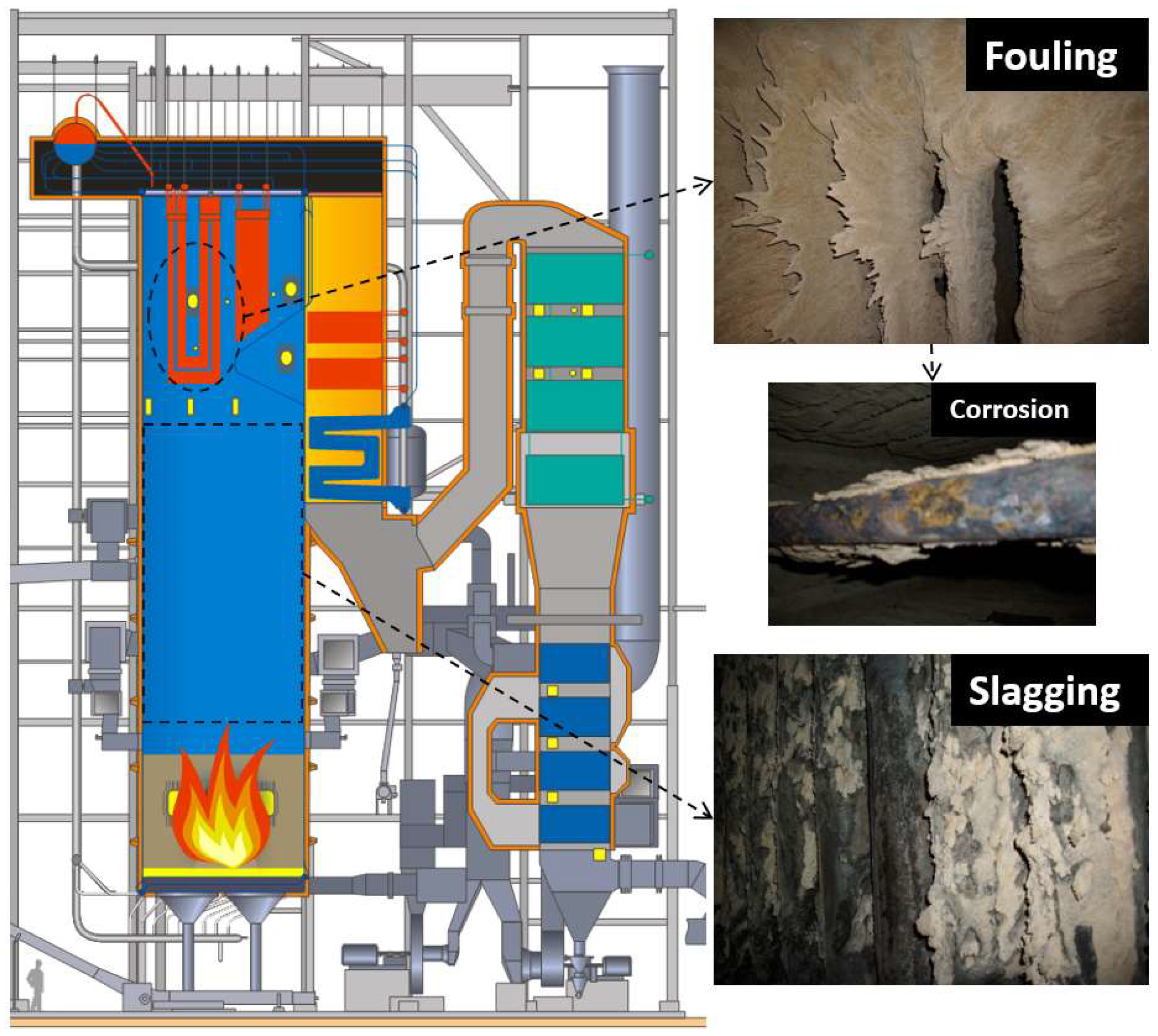
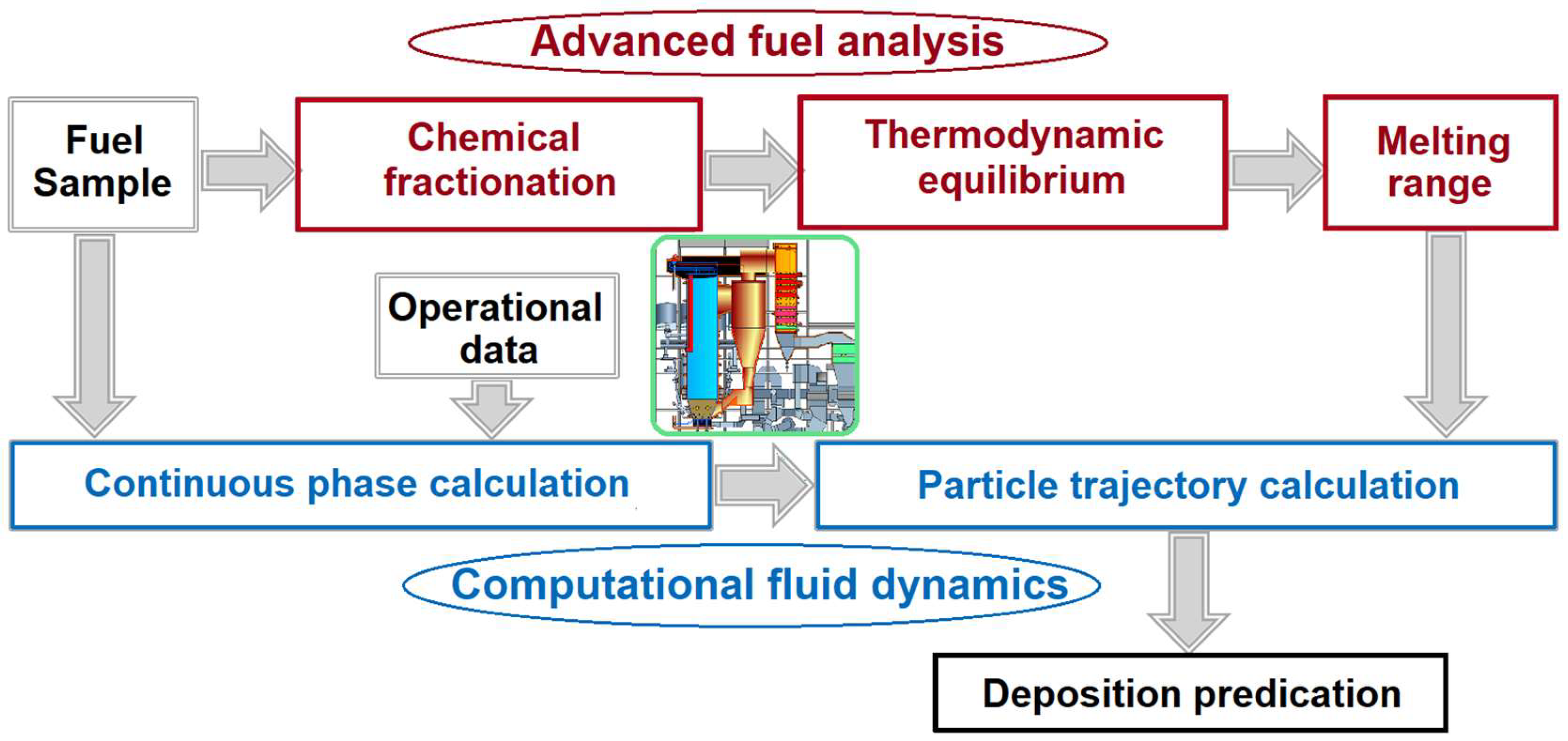
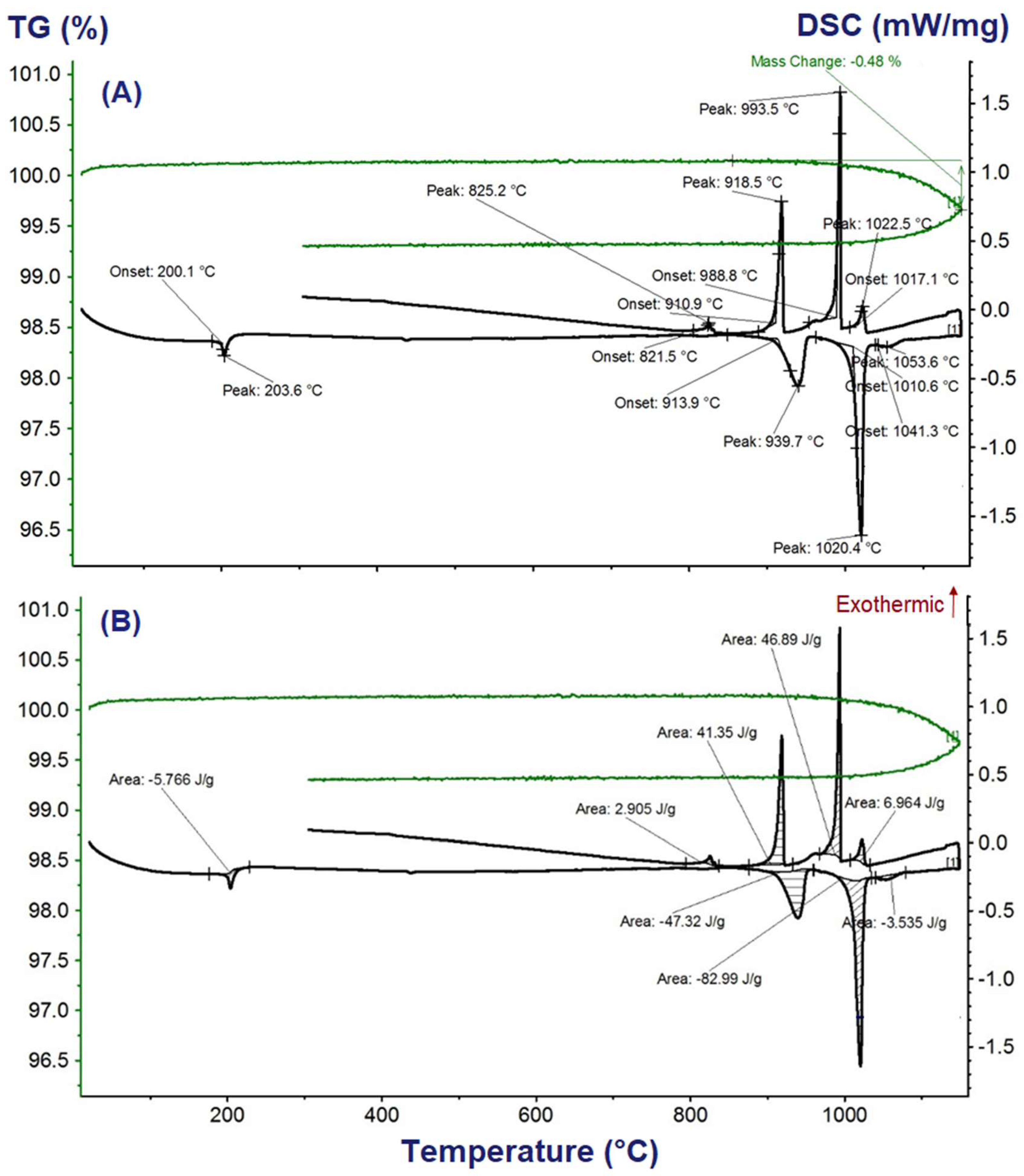
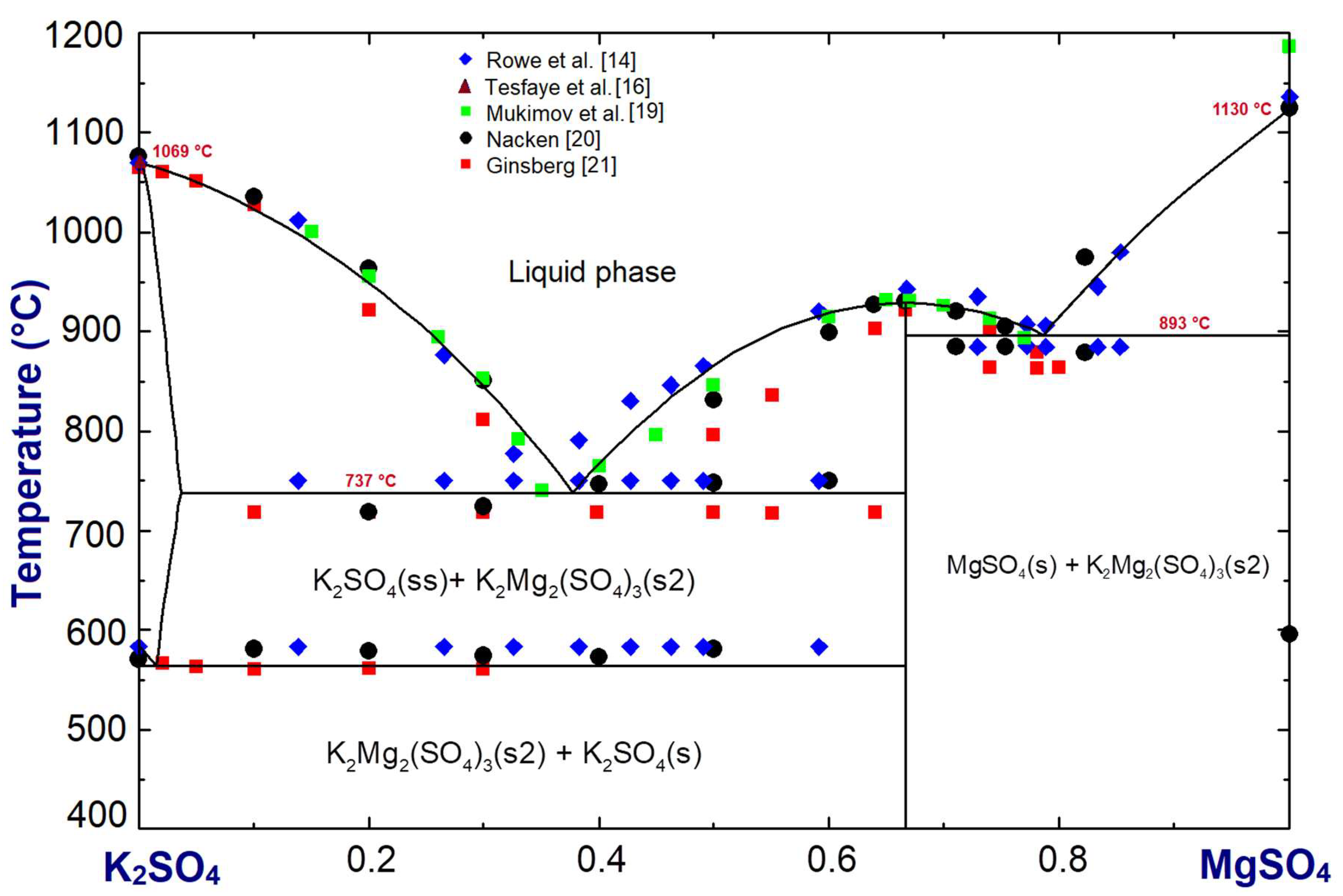
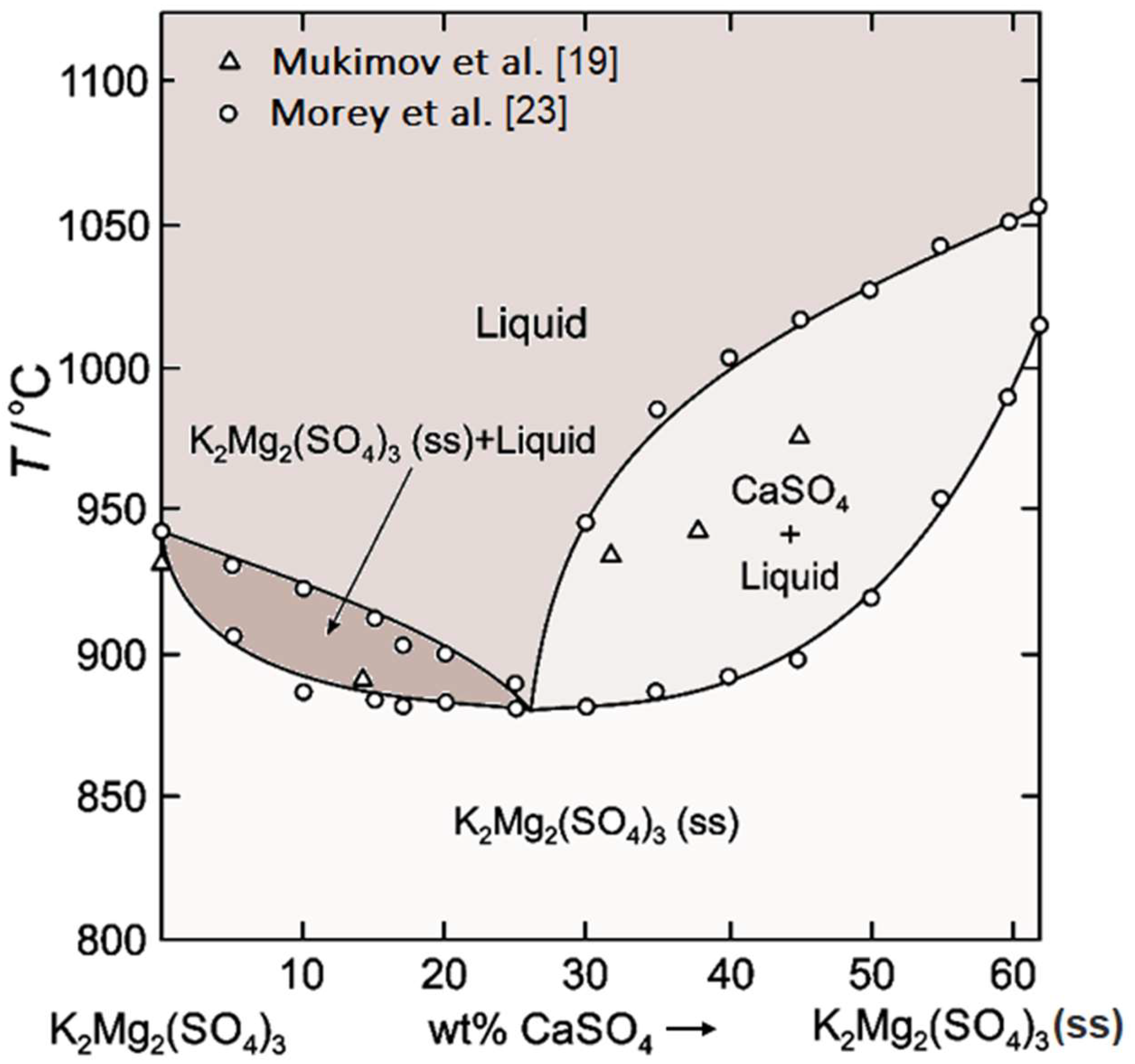
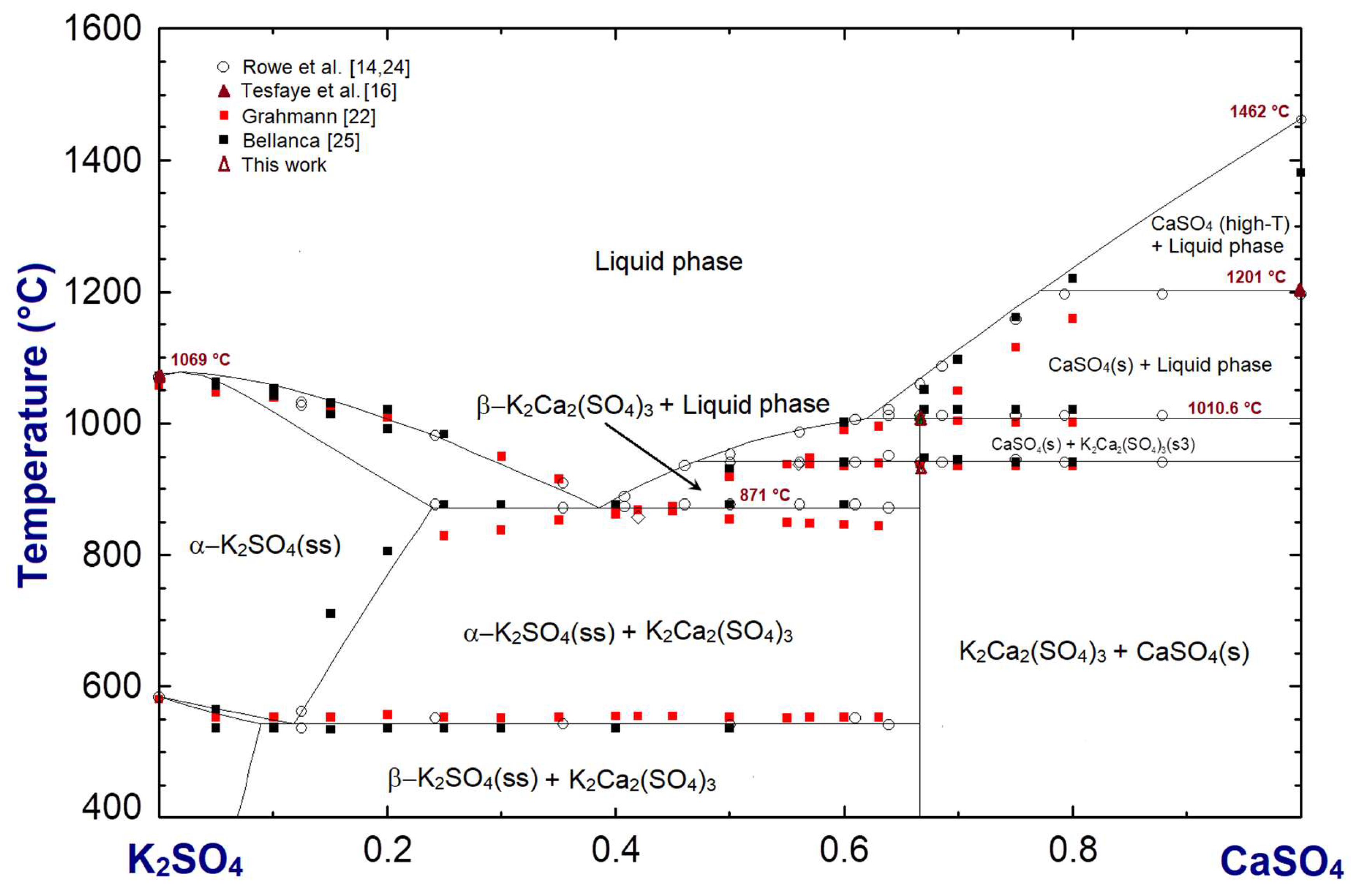
| Phase | Ttra(1)/°C | Ttra(2)/°C | ∆trH°/kJ·mol−1 | Tmelt/°C | ∆meltH°/kJ·mol−1 | Ref. |
|---|---|---|---|---|---|---|
| K2SO4 | 586.1 ± 1 | None | 7.2 ± 0.1 | 1069.2 ± 1 | 21.12 ± 0.3 | [16] |
| 583 | - | 1069 | - | [14,33] | ||
| 581 | - | 1067 | - | [34] | ||
| CaSO4 | 1201 ± 1 | None | 9.1 ± 0.1 | - | - | [16] |
| 1195 ± 2 | - | 1462 ± 4 | - | [14,24] | ||
| 1199 | 29.43 | - | - | [33] | ||
| 1193 | - | 1450 | 28.1 | [35] | ||
| MgSO4 | - | None | - | 1136 ± 4 | - | [14] |
| 1110 | - | - | 1130 | 14.6 | [35] | |
| 1015 | - | 18.08 | - | - | [33] | |
| K2Ca2(SO4)3 | 200.1 ± 1 | 914 ± 1 | 2.6 ± 0.1tra(1) | 1010.6 ± 1 1 | 37.1 ± 0.6 | This work |
| 201.5 ± 0.1 | - | 2.1 ± 0.02tra(1) | - | - | [15] | |
| 184 | - | - | - | - | [33] | |
| - | 936 | - | 1004 1 | - | [19] | |
| - | 940 | - | 1011 1 | - | [14] | |
| 200 ± 2 | - | - | 1009–1013 1 | - | [23] | |
| K2Mg2(SO4)3 | - | - | - | 943 | - | [23] |
| - | - | - | 930 | - | [19,20] |
| Reaction | Tmelt/°C | Remark |
|---|---|---|
| K2SO4 + MgSO4 ⇄ K2SO4(ss) + Liquid phase | 737–1069 | Melting of K2SO4 with solid solution of up 3.6 mol.% MgSO4 |
| K2SO4 + CaSO4 ⇄ K2SO4(ss) + Liquid phase | 871–1069 | Melting of K2SO4 with solid solution of up 24.1 mol.% CaSO4 |
| MgSO4 ⇄ Liquid phase | 1130 | Congruent melting |
| CaSO4 ⇄ Liquid phase | 1462 | Congruent melting |
| K2Mg2(SO4)3 ⇄ Liquid phase | 930 | Congruent melting |
| K2Mg2(SO4)3 + CaSO4 ⇄ K2Mg2(SO4)3(ss) + Liquid phase | 885–930 | Melting of K2Mg2(SO4)3 with solid solution of up 18 mol.% CaSO4 |
| K2SO4(ss) + K2Mg2(SO4)3 ⇄ Liquid phase | 737 | Eutectic melting |
| MgSO4 + K2Mg2(SO4)3 ⇄ Liquid phase | 893 | Eutectic melting |
| K2Ca2(SO4)3 ⇄ Liquid phase | 1011 | Congruent melting |
| K2SO4(ss) + K2Ca2(SO4)3 ⇄ Liquid phase | 871 | Eutectic melting |
| K2Ca2(SO4)3 + CaSO4 ⇄ Liquid phase + CaSO4 | 1011 | Congruent melting |
Publisher’s Note: MDPI stays neutral with regard to jurisdictional claims in published maps and institutional affiliations. |
© 2020 by the authors. Licensee MDPI, Basel, Switzerland. This article is an open access article distributed under the terms and conditions of the Creative Commons Attribution (CC BY) license (http://creativecommons.org/licenses/by/4.0/).
Share and Cite
Tesfaye, F.; Lindberg, D.; Moroz, M.; Hupa, L. Investigation of the K-Mg-Ca Sulfate System as Part of Monitoring Problematic Phase Formations in Renewable-Energy Power Plants. Energies 2020, 13, 5366. https://doi.org/10.3390/en13205366
Tesfaye F, Lindberg D, Moroz M, Hupa L. Investigation of the K-Mg-Ca Sulfate System as Part of Monitoring Problematic Phase Formations in Renewable-Energy Power Plants. Energies. 2020; 13(20):5366. https://doi.org/10.3390/en13205366
Chicago/Turabian StyleTesfaye, Fiseha, Daniel Lindberg, Mykola Moroz, and Leena Hupa. 2020. "Investigation of the K-Mg-Ca Sulfate System as Part of Monitoring Problematic Phase Formations in Renewable-Energy Power Plants" Energies 13, no. 20: 5366. https://doi.org/10.3390/en13205366
APA StyleTesfaye, F., Lindberg, D., Moroz, M., & Hupa, L. (2020). Investigation of the K-Mg-Ca Sulfate System as Part of Monitoring Problematic Phase Formations in Renewable-Energy Power Plants. Energies, 13(20), 5366. https://doi.org/10.3390/en13205366







